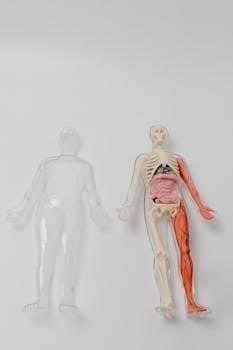Nursing Case Study Sample PDF⁚ An Overview
A nursing case study is a detailed exploration of an individual patient’s experience. This document delves into the patient’s symptoms, medical history, and impacting factors, which leads to a proper diagnosis. These case studies analyze care from admission to termination of the nurse-patient relationship.
What is a Nursing Case Study?
A nursing case study is a comprehensive, in-depth analysis of a specific patient’s experience with a health issue or condition. It’s a research method used in healthcare to examine a particular situation, exploring the patient’s medical history, symptoms, and the care they received. Unlike general reports, a case study focuses on a single case, providing a detailed overview of the patient’s journey, from admission to the conclusion of the nurse-patient relationship. This method helps to enhance understanding of complex cases, improve diagnostic skills, and promote critical thinking among nurses. Through case studies, nurses can delve into the intricacies of a patient’s condition, including any specific factors that might have influenced the health outcome, thus offering valuable insights for better patient care. It is a vital tool for learning and professional development in nursing.
Purpose of Nursing Case Studies
The primary purpose of nursing case studies is to enhance the critical thinking and analytical skills of nursing professionals. By examining detailed patient scenarios, nurses can develop a deeper understanding of complex health issues and refine their diagnostic abilities. Case studies provide a framework for exploring the intricacies of patient care from admission to discharge, including assessment, planning, implementation, and evaluation. They serve as valuable tools for bridging the gap between theoretical knowledge and practical application, offering real-world examples of the challenges and opportunities encountered in nursing practice. Furthermore, case studies promote reflective practice, allowing nurses to analyze their interventions and outcomes, ultimately contributing to improvements in patient care. They are also useful for educating students and for sharing best practices within the nursing profession.

Key Components of a Nursing Case Study
A comprehensive nursing case study includes patient information, assessment, nursing diagnoses, care planning, implemented interventions, and an evaluation of care outcomes. These components are essential for a thorough analysis.
Patient Information and History
This section of a nursing case study meticulously documents the patient’s demographic details, including age, gender, and relevant background. It also includes the patient’s past medical history, which is very important. This history includes previous illnesses, surgeries, and any chronic conditions. A comprehensive account of their family medical history is also very important, as it helps to identify any potential hereditary predispositions. Furthermore, a detailed social history is provided, which contains lifestyle factors such as occupation, diet, and substance use, which is very important in understanding their health status. This section also details the patient’s presenting complaint, the specific reason for seeking medical help. This information is crucial in forming a holistic understanding of the individual and guides the subsequent nursing assessment. Accurate documentation here is essential for proper diagnosis and care planning. This information provides a foundation for understanding the patient’s current condition.
Assessment and Data Collection
This segment of a nursing case study focuses on the systematic gathering of both subjective and objective data about the patient. This involves a comprehensive physical examination, noting vital signs, and observing the patient’s overall condition. Subjective data is collected through patient interviews, gathering their perceptions of their symptoms and health concerns. Objective data includes physical findings, results from lab tests, imaging, and other diagnostic procedures which provide factual evidence. A detailed analysis of the collected data is crucial. It requires critical thinking to identify patterns, abnormalities, and potential health risks. The nursing assessment also includes a psychosocial evaluation, assessing the patient’s emotional state, coping mechanisms and support systems. The information obtained in this phase forms the basis for identifying nursing diagnoses and developing an effective care plan. This information is essential for determining the patient’s current health status.
Nursing Diagnoses and Care Planning
Following a thorough assessment and data collection, the next step is to formulate nursing diagnoses. These diagnoses identify actual or potential health problems that nurses are qualified and licensed to treat. This involves analyzing the assessment data to identify the patient’s specific needs and health issues. The nursing diagnoses serve as the basis for developing an individualized care plan. The care plan outlines specific goals, interventions, and expected outcomes tailored to the patient’s unique needs. This involves setting priorities, considering the patient’s physical, emotional, and social needs. Care plans should be patient-centered, involving the patient and their family in the planning process. The plan also includes interventions that nurses will implement to address the identified problems. These interventions include monitoring, providing medications, educating, and other therapeutic actions. Care planning is a dynamic process that requires ongoing evaluation and adjustments.
Nursing Interventions and Implementation
Once the care plan is established, the next phase is the implementation of nursing interventions. This involves carrying out the specific actions outlined in the care plan to address the patient’s health needs. These actions may include administering prescribed medications, performing wound care, assisting with mobility, providing patient education, and monitoring vital signs. The implementation phase requires critical thinking, effective communication, and skillful execution. Nurses must be able to adapt interventions based on patient responses and changes in condition, always ensuring patient safety. Documentation of implemented interventions and observations is a critical aspect of this phase. Detailed records of care and patient responses are essential for monitoring progress and evaluating the care plan’s effectiveness. Nurses must work collaboratively with other healthcare professionals, such as doctors, therapists, and social workers, to ensure coordinated and comprehensive care. The implementation phase is dynamic, requiring continuous reassessment and adjustment of interventions to meet the patient’s evolving needs and goals.
Evaluation of Care and Outcomes
The final phase of a nursing case study is the evaluation of care and outcomes. This involves assessing the effectiveness of the implemented nursing interventions in achieving the desired patient goals. This process includes analyzing the patient’s response to the interventions, changes in their condition, and any adverse effects. Evaluation utilizes both objective data, such as vital signs and lab results, and subjective data, such as the patient’s self-reported symptoms and feelings. A crucial element of this phase is to determine if the nursing diagnoses were accurately identified and if the care plan was appropriate. If goals were not met, the evaluation phase involves analyzing the reasons, and making necessary revisions to the plan. The nurse reflects on the entire process, noting what worked well and areas for improvement in future case studies. Documenting the evaluation and patient outcomes is essential for communicating the effectiveness of care and for informing evidence-based nursing practice.

Examples and Formats
Exploring case studies, like one about Kawasaki disease, provides practical insights. Various formats and templates are available, including reflective models, which aid in comprehensive analysis and enhance learning through real-world scenarios.
Kawasaki Disease Case Study Example
A compelling example of a nursing case study involves a 1.5-year-old male, named Baby James, who was admitted with a fever and subsequently diagnosed with Kawasaki disease. This case study provides a detailed exploration of this rare condition, highlighting the importance of early recognition and intervention. The study would likely delve into the patient’s presenting symptoms, such as fever, rash, and changes in mucous membranes, as well as the diagnostic process and treatment plan. This specific case study aims to increase awareness and understanding of Kawasaki disease among healthcare professionals. It also emphasizes the critical role of nurses in assessing, planning, implementing, and evaluating care for pediatric patients with such complex conditions. Furthermore, it is a practical example which demonstrates the application of theoretical nursing knowledge in a real-world clinical setting, offering valuable insights into the management of this challenging illness, and how it affects the patient and their family. The case would also examine the nursing interventions provided and their impact on the child’s recovery.
Case Study Formats and Templates
Nursing case studies often follow structured formats to ensure comprehensive analysis. A typical format includes sections like patient information, presenting problems, past medical history, assessment findings, nursing diagnoses, care plans, interventions, and evaluation of outcomes. Templates can provide a framework for organizing information logically and consistently. These templates often include headings and prompts that guide the writer through each step of the case study process. They may also incorporate specific frameworks, such as the nursing process or reflective models. Utilizing these standardized formats and templates helps to facilitate clear communication and critical thinking. Moreover, these tools are essential in ensuring that all vital aspects of patient care are addressed. Such templates are valuable for students and practicing nurses alike, as they offer a structured approach to analyzing complex patient scenarios. They serve as a guide for collecting and presenting data in a meaningful and systematic manner, ultimately improving patient care.
Reflective Models in Case Studies
Reflective models are crucial in nursing case studies as they provide a structure for analyzing experiences and improving practice. These models encourage nurses to look back on their actions, thoughts, and feelings to understand what went well and what could be improved. Common reflective models include Gibbs’ reflective cycle, which involves describing the situation, analyzing feelings, evaluating the experience, drawing conclusions, and developing an action plan. Using a reflective model helps nurses to move beyond simple description to deeper understanding and learning. This process supports the development of critical thinking and professional growth; Reflective practice is essential for nurses to continually enhance their skills and provide better patient care. By using these models, nurses can identify areas where they excelled and areas where they need further development. This process of continuous improvement is at the heart of reflective practice. These models encourage self-assessment and a commitment to lifelong learning.

Resources and Support
Numerous resources are available to assist in writing nursing case studies. These include online guides, university materials, and tools designed for nurses to enhance their skills and knowledge in this area.
Where to Find Case Study Examples
Finding relevant case study examples is crucial for understanding the application of nursing principles. Numerous online resources offer free nursing case studies, often with answers, which are beneficial for students and practicing nurses alike. Websites like Studocu and Smartn provide access to various case studies, some specifically formatted for the Next Generation NCLEX (NGN). Additionally, some universities, such as the University of Maryland, Baltimore, offer resources and examples through their academic portals. Furthermore, many nursing journals and publications include case study articles that can serve as excellent models. These examples span a wide range of conditions, from common illnesses to rare diseases like Kawasaki disease. Utilizing these resources can significantly enhance the understanding and creation of effective nursing case studies.
Tools and Guides for Writing Case Studies

Writing effective nursing case studies requires structure and guidance. Various tools and guides are available to assist in this process. Templates, often available as PDFs, provide a framework for organizing information, from patient history to care evaluation. Reflective models are also recommended to aid in the analysis of the case study, ensuring a comprehensive approach. These models help structure critical thinking and provide an analytical lens for each element of the study. Additionally, resources from academic institutions and online platforms offer step-by-step instructions on how to gather relevant data, assess patient needs, and formulate nursing diagnoses. These guides frequently include checklists and examples of proper documentation and analysis. By using these tools and guides, students and nurses can confidently develop well-structured, informative case studies that enhance their learning and practice.
University and Online Resources
Universities and online platforms offer a wealth of resources for those seeking to improve their understanding and skills in nursing case study writing. Many academic institutions provide access to libraries filled with relevant research materials, textbooks, and published case studies. Moreover, university websites often host guides and templates specifically designed for nursing students. Online resources also play a critical role, with various websites offering free case studies, writing tips, and examples. Platforms like Studocu provide access to lecture notes and summaries that can aid in understanding the theoretical concepts behind case studies. Furthermore, some websites host virtual case studies with interactive scenarios, allowing students to apply their knowledge and make clinical decisions. These resources collectively offer a comprehensive learning environment for students and nurses alike, improving their competence in practical applications and critical thinking skills.

Leave a Reply
You must be logged in to post a comment.